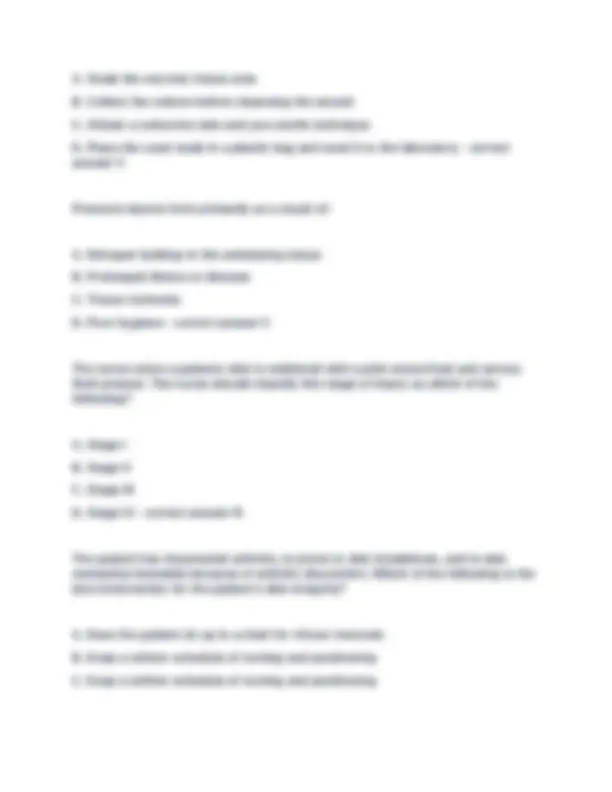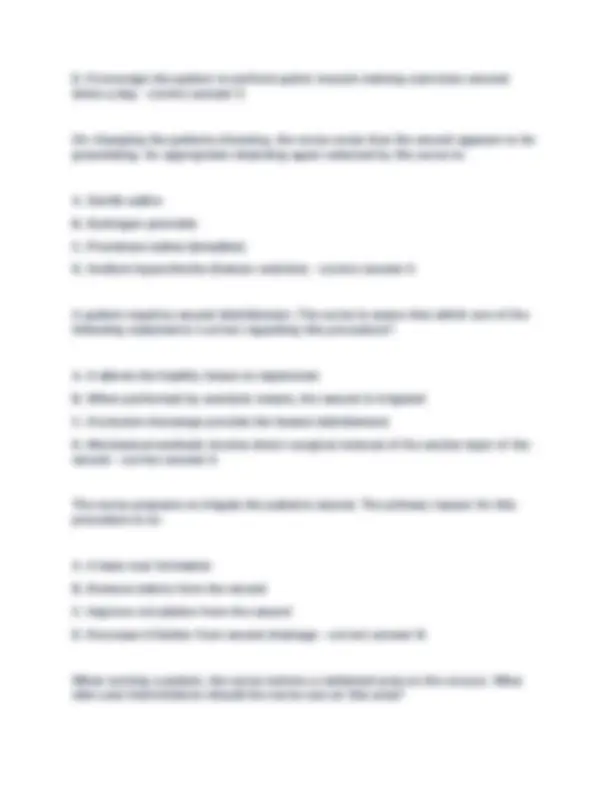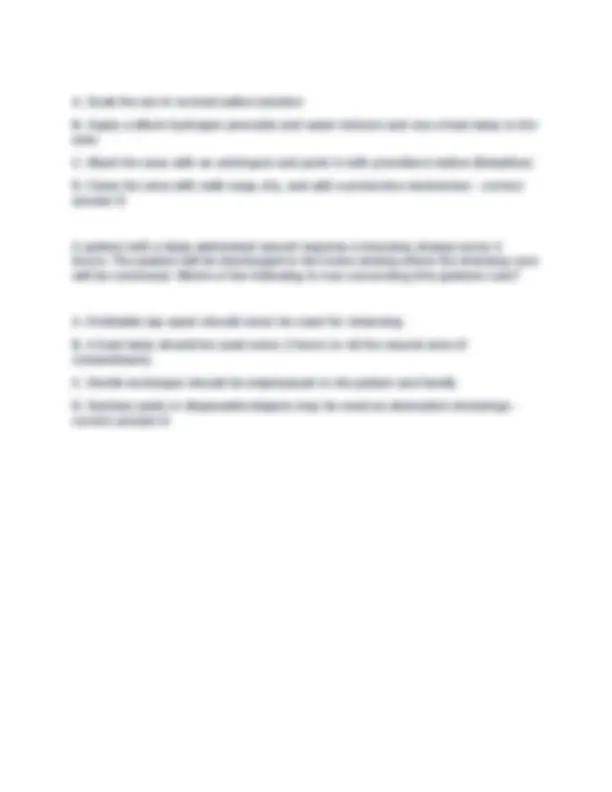





Study with the several resources on Docsity

Earn points by helping other students or get them with a premium plan


Prepare for your exams
Study with the several resources on Docsity

Earn points to download
Earn points by helping other students or get them with a premium plan
Community
Ask the community for help and clear up your study doubts
Discover the best universities in your country according to Docsity users
Free resources
Download our free guides on studying techniques, anxiety management strategies, and thesis advice from Docsity tutors
SKIN INTEGRITY WOUND CARE ATI QUESTIONS AND STUDY BOOK A nurse is caring for a client who is 2 days postoperative following an appendectomy and has type I diabetes myelitis. Their Hgb is 12 g/dL and BMI is 17.1. This incision is approximated and free of redness, with scant serous drainage on the dressing. The nurse should recognize that the client has which of the following risk factors for impaired wound healing? Select all that apply A. Extreme in age B. Chronic illness C. Low hemoglobin D. Malnutrition E. Poor wound care - correct answer B,c,d
Typology: Exams
1 / 5

This page cannot be seen from the preview
Don't miss anything!




A nurse is caring for a client who is 2 days postoperative following an appendectomy and has type I diabetes myelitis. Their Hgb is 12 g/dL and BMI is 17.1. This incision is approximated and free of redness, with scant serous drainage on the dressing. The nurse should recognize that the client has which of the following risk factors for impaired wound healing? Select all that apply A. Extreme in age B. Chronic illness C. Low hemoglobin D. Malnutrition E. Poor wound care - correct answer B,c,d A nurse is collecting data from a client who is 5 days postoperative following abdominal surgery. The surgeon suspects an incisional wound infection and has prescribed antibiotic therapy for the nurse to initiate after collecting wound and blood specimens for culture and sensitivity. Which of the following findings should the nurse expect? Select all that apply A. Increase in incisional pain B. Fever and chills C. Reddened wound edges D. Increase in serosanguineous drainage E. Decrease in thirst - correct answer A,b,c A nurse educator is reviewing the wound healing process with a group of nurses. The nurse educator should include in the information. Which of the following alterations for wound healing by secondary intention? Select all that apply
A. Stage 3 pressure injury B. Sutured surgical fracture C. Casted bone fracture D. Laceration sealed with adhesive E. Open burn area - correct answer A,e A client who had abdominal surgery 24 he ago suddenly reports a pulling sensation and pain in their surgical incision. The nurse checks the surgical wound and finds it separated with viscera protruding. Which of the following actions should the nurse take? Select all that apply A. Cover the area with saline-soaked sterile dressings B. Apply an abdominal binder snugly around the abdomen C. Use sterile gauze to apply settle pressure to the exposed tissues D. Position the client supine with the hips and knees bent E. Offer the client a warm beverage (herbal tea) - correct answer A,d A nurse is caring for a client who is at risk for developing pressure injury. Which of the following interventions should the nurse use to help maintain the integrity of the clients skin? Select all that apply A. Keep the head of the bed elevated 30 degrees B. Massage the clients bony prominences frequently C. Apply cornstarch liberally to the skin after bathing D. Have the client sit in a gel cushion when in a chair E. Reposition the client at least every 3 he while in bed - correct answer A,d The nurse determines that the patient's wound may be infected. To perform an aerobic wound culture, the nurse should:
D. Encourage the patient to perform pelvic muscle training exercises several times a day - correct answer C On changing the patients dressing, the nurse notes that the wound appears to be granulating. An appropriate cleansing agent selected by the nurse is: A. Sterile saline B. Hydrogen peroxide C. Providone iodine (betadine) D. Sodium hypochlorite (Damon solution) - correct answer A A patient requires wound debridement. The nurse is aware that which one of the following statements I correct regarding this procedure? A. It allows the healthy tissue to regenerate B. When performed by autolytic means, the wound is irrigated C. Occlusive dressings provide the fastest debridement D. Mechanical methods involve direct surgical removal of the eschar layer of the wound - correct answer A The nurse prepares to irrigate the patients wound. The primary reason for this procedure is to: A. Create scar formation B. Remove debris from the wound C. Improve circulation from the wound D. Decrease irritation from wound drainage - correct answer B When turning a patient, the nurse notices a reddened area on the coccyx. What skin care interventions should the nurse use on this area?
A. Soak the are in normal saline solution B. Apply a dilute hydrogen peroxide and water mixture and use a heat lamp to the area C. Wash the area with an astringent and point it with providone-iodine (Betadine) D. Clean the area with mild soap, dry, and add a protective moisturizer - correct answer D A patient with a large abdominal wound requires a dressing change every 4 hours. The patient will be discharged to the home setting where the dressing care will be continued. Which of the following is true concerning this patients care? A. Drinkable tap water should never be used for cleansing B. A heat lamp should be used every 2 hours to rid the wound area of contaminants. C. Sterile technique should be emphasized to the patient and family D. Sanitary pads or disposable diapers may be used as absorptive dressings - correct answer D